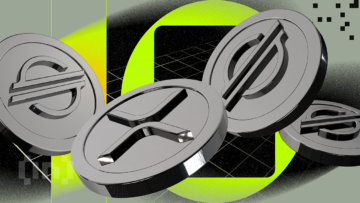Algorithmic stablecoins are the ultimate innovation of decentralized finance that promises to upgrade how stablecoins work. For the unversed, stablecoins and cryptocurrencies are able to support the ever-expanding financial markets through transparent smart contracts, without the need for central banks. Yet, not every stablecoin works alike: there are rebase and seigniorage stablecoins.
Others have the backing of fiat currencies, some use commodity or even crypto as collateral. Algorithmic stablecoins differ from other variants— both in terms of functioning and even market cap. They rely heavily on smart contracts and intelligent algorithms to maintain value. At the core, these stablecoins aim for the highest level of decentralization.
Let’s dig deeper to explore how algorithmic stablecoins work, how they maintain the peg like other collateralized digital assets, and how the crypto markets react to these special tokens.
In this guide:
What are stablecoins?

Stablecoins are stable crypto assets with fiat, commodity, financial instrument, or an algorithm backing their presence. Ideators develop Stablecoins to offer an alternative to the high volatility cryptocurrencies, such as bitcoin (BTC) or ether (ETH). During highly volatile market trends, investors trade their highly volatile assets for stablecoins to maintain the value of their portfolios.
Most stablecoins represent a way to earn a passive income from your crypto holdings. There are many platforms that offer great interest rates for stablecoins (much better than anything offered by traditional finance).
How do stablecoins work?
As the more stable versions of crypto, stablecoins keep external references in mind and try keeping the peg to those reference values. For instance, one USDT or Tether token tries to stay as close to the one-dollar peg. How they maintain the peg determines their type!
Different types of stablecoins
As simple as it may seem, the future of digital currency isn’t deterministic yet. Many believe that stablecoins should be considered a legal tender, not controlled by any central authority such as central banks. However, based on how they stabilize their value, there is more than one type of stablecoin:
- Fiat-collateralized stablecoins
- Collateralized by other cryptocurrencies
- Collateralized by an algorithmic ecosystem
Fiat-collateralized stablecoins
These stablecoins have fiat currencies to back them. These digital assets have fiat currencies — such as the U.S. dollar — as collateral to ensure its value, usually in a 1:1 ratio. Other popular collateral choices include precious metals such as gold and silver. However, most stables that are collateralized by fiat have a dollar peg.
These U.S. dollar reserves are managed by independent custodians who are periodically audited. For instance, Tether (USDT) and TrueUSD (TUSD) are two popular stablecoins that are backed by U.S. dollars and are paired at a 1:1 ratio. You can buy stablecoins on most exchanges.
Crypto-collateralized stablecoins
Stablecoins can also be crypto-collateralized— meaning they have the backing of other crypto assets. Because the reserve of the cryptocurrency backing the stablecoin may also be prone to high volatility, overcollateralization is often a norm for them. This means that the value of cryptocurrency held in reserves exceeds the value of the stablecoins issued.
For instance, to protect against a 50% drop in the price of the stablecoin, the crypto reserve could be as much as double the value of the issued stablecoins. MakerDAO’s stablecoin (DAI) is a prime example. It maintains a dollar peg with Ether (ETH) reserves and other cryptocurrencies backing it. The reserves are worth 150% of the total supply of DAI stablecoin, give or take.
Algorithmic stablecoins
Another type of stablecoin that has been gaining popularity over the last couple of years is the algorithmic stablecoin. These stablecoins may also lock down some assets to collateralize the value of the stable, but they mostly rely on an algorithm. Smart contracts maintain the supply and demand cycle of algorithmic stablecoins.
As there is no central reserve in play, you can even term them decentralized stablecoins. Ecosystem participants can interact with a smart contract to exchange the stablecoin. By selling or buying the algorithmic stablecoin to the system, users can expand or contract the total supply.
Algorithmic stablecoins are not that different from currency issued by central banks, which may not depend on a reserve asset for keeping the currency’s value stable. This type of stablecoin started to attract more attention, as one of the most popular algorithmic stablecoins — TerraUSD (UST) — lost its peg on May 9, 2022, causing the dramatic drop of Terra (LUNA), which almost reached zero. This is an exceptional example of what can happen when an algorithmic stablecoin is being manipulated.
What are algorithmic stablecoins?

Algorithmic stablecoins maintain price stability by using smart contracts for maintaining the supply-demand balance. These decentralized stablecoins are tied to a reserve asset like the U.S. Dollar despite relying on the dollar values as peg reference. In other words, they use algorithms that can mint more coins when the price rises and then buy them off and burn them when the price falls. This arrangement often involves two tokens. Remember UST and LUNA?
A critical note here is that algorithmic stablecoins, in their purest form, do not rely on collateral. They are not supported by any external asset. They use algorithms, which are specific instructions or rules that must be followed to produce a result. These computer algorithms are designed to encourage market participants to trade stablecoins according to supply and demand. This action manipulates the circulating supply to ensure that any coin’s price is stable around its peg.
Benefits of algorithmic stablecoins
Algorithmic stablecoins could increase the popularity of cryptocurrency as a medium of exchange for financial transactions and other purposes.
These applications include the use of stablecoins for trading, using them to run DAOs (decentralized autonomous organizations), and providing incentives to holders.
Similar to the way central banks issue new coins, algorithmic stablecoins are designed to expand or contract their total supply to maintain their peg. But in the case of these algorithmic stablecoins, the token holders are the ones to benefit from the price difference and not a central entity.
/Related
More ArticlesAnother benefit is the exact utility of the token. Usually, these stablecoins are not only a medium to exchange value, but can also play their part in certain decentralized protocols. Staking stablecoins is one of the most popular use cases.
The basics of stablecoins are fairly easy to understand, but like with all things crypto, the deeper you go, the more there is to process. Learn everything you need to know at the BeInCrypto Telegram group.

Risks of algorithmic stablecoins
New investors may think that algorithmic stablecoins are low-risk. While they are certainly less volatile than popular cryptocurrencies, it’s important to remember that algorithmic stablecoins have no specific backing.
In the case of algorithmic stablecoins, their design aims to maintain price stability through the actions of the users who interact with the system. If there is no big incentive for investors to buy the secondary tokens that could bring the price of the stablecoin back up to its peg, the contraction mechanism could fail. There is a possibility that the stablecoin never manages to maintain the peg. This happens when the stablecoin burning frequency is low and the investors keep selling. This approach can case depegging, leading to a “death spiral.”
TerraUSD (UST) is an excellent example of a stablecoin that recently experienced the death spiral.
Imagine UST is in a working state now. Here is how the peg process works: to maintain its USD valuation, it uses Terra’s native cryptocurrency, LUNA, as a secondary token. Each time the UST goes over $1, investors sell it to the system and get LUNA tokens in return.
When the UST price dips below $1, users can sell LUNA tokens and get $1 worth of UST. The algorithm will always value UST at $1, regardless of the market conditions at that time. This approach makes crypto arbitrage possible, as the price difference can generate a profit. But as users start losing faith in the Terra system with UST depegging, both of these tokens imploded, and investors got liquidated.
Some other risks are similar to those associated with cryptocurrency in general, including security and storage. Users need to store them on a trusted cryptocurrency wallet and only use reputable exchange platforms when trading them.
Understanding Crypto Depegging
If you read the term “depegging” quite a lot in the above-mentioned sections, fret not as it isn’t all that complex. It simply is an unfortunate phenomenon where the price of a stablecoin, regardless of its type, deviates from its reference value.
For instance, if one USDC token drops lower than $1, you might say that it has depegged.
How do algorithmic stablecoins work?

The main types of algorithmic stablecoins are seigniorage and rebase.
Rebase stablecoins
How do rebase stablecoins work? To maintain the peg, rebase stablecoins impact or rather stretch/contract the supply. You can also term rebase stablecoins as elastic tokens.
Typically, rebase tokens are pegged to another asset. Instead of using reserves to keep the peg in place, rebase tokens automatically put tokens into circulation by minting new tokens when the price drops below their pegged value of $1. The algorithm also burns tokens when the value of the pegged token drops under the $1 value. Despite the supply volatility, its price tends not to fluctuate, and it depends on the value of the asset it tracks.
Seigniorage stablecoins
The second type of algorithmic stablecoins is the seigniorage stablecoins. In traditional finance, seigniorage implies to the difference between a currency’s face value and the production costs. The point is to make a profit from the price difference by those who hold the token that acts as a share or bonds of the system.
How do seigniorage stablecoins work?
While the mechanics of a seigniorage stablecoin can vary from project to project, the principles are the same. The stablecoin financial system can perform automatic actions, to counteract the different possibilities — to lower or to increase the value of the stable and get it back to its pegged value. Usually, the system needs a few tokens — the stablecoin, a token to act as shares, and another one to act like bonds. The shares and the bonds are used to adapt and control the supply of the stablecoin.
What happens when the seigniorage stablecoin’s value is above its peg? The system mints more seigniorage stablecoins automatically to meet the current demand and retain the peg to the value of $1 — as part of the expansion mechanism.
Here, the users holding the token that acts as shares will receive a corresponding percentage of the newly minted seigniorage stablecoin quantity. That’s a reward for the share token holders, as they bear the riskiest asset in this seigniorage stablecoin mechanism. Of course, these holders can then sell their newly received stablecoins, which will result in a decrease in the seigniorage stablecoin’s price.
What happens when a stablecoin loses its peg?
This is a slightly trickier situation. In this case, the algorithmic system tries to burn the excess stablecoin to lower the supply. This can, in turn, restore the peg — as part of the contraction mechanism.
If the stablecoin’s value is under $1, the algorithm allows users to exchange the stablecoin for the token that acts as bonds, therefore decreasing the supply of the stablecoin. The system also guarantees that users get more than 1 bond token for each stablecoin. When the stablecoin restores its peg, users are able to redeem one bond token for one stablecoin. Thus, they make profit even when the market cap of the stablecoins change.
What are some examples of algorithmic stablecoins?
Let’s share some light on how exactly algorithmic stablecoins work, with the help of examples of the most popular ones. Here are the top algorithmic stablecoins that can help you understand their functionality.
Basis Cash (BAC) — Do Kwon’s first stablecoin project

Do Kwon, Terra’s creator, also has other failed stablecoins in the portfolio, apart from the recently released LUNA. Remember the Basis Cash (BAC), which he released under the Rick Sanchez pseudonym and as one of the first algorithmic stablecoins. BAC’s goal was to maintain a 1:1 dollar peg.
The protocol of BAC was created to contract and expand supply in a manner similar to central banks trading fiscal debt to stabilize purchasing powers without collateral. The Basis Share, Basis Bond, and Basis Cash were all intended to be exchangeable. Do Kwon intended to distribute BAC tokens via yield farming and liquidity to BAC-DAI.

However, Basis Cash (BAC) depegged from the U.S. dollar, and thus it failed to be a reliable stablecoin. Today, the coin trades below $0.01, and it lost support from investors (and their trust).
Ampleforth (AMPL)

Ampleforth is an Ethereum-based protocol that aims to maintain the value of the AMPL cryptocurrency asset at an equal value to the U.S. Dollar.
Evan Kuo, a serial entrepreneur and Brandon Iles and an ex-Google senior software engineer, ideated Ampleforth. The Ampleforth Foundation is the management and development firm behind the Ampleforth protocol, and the team has around a dozen members, per their LinkedIn page.
The AMPL stablecoin came forth as a rebase stablecoin. This means that instead of owning a fixed number of AMPL, the holders own a fixed percentage of the total AMPL circulating supply. The total supply contracts or expands according to the current token price. If the AMPL price is over $1, the protocol increases the circulating supply and distributes the newly minted tokens to existing holders. However, the AMPL token supply decreases when the AMPL price drops below $1.
All Ampleforth wallets will be affected by this change. Their wallet balances will be adjusted in proportion. AMPL holders will retain the same token supply, regardless of this change. This means that even if you had 1% of AMPL tokens prior to a rebasing, you would still have the same percentage of the total supply after the rebasing.

Rebase, or as we know it, happens once every day. A positive rebase is when the price rises above $1.06, and a negative one is when it falls below $0.96. The system’s overall purpose is to provide incentives to drive AMPL’s market price back down to $1.
TerraUSD (UST)

TerraUSD (UST) is the Terra (now Terra Classic) blockchain’s fabled algorithmic stablecoin. It is a yield-bearing, scalable coin that aims to be value-pegged to the U.S. dollar. TerraUSD was designed to provide value to the Terra community and offer a scalable solution to Decentralized Finance (DeFi) applications.
Terraform Labs developed the UST in 2018 — in a project led by Do Kwon and Daniel Shin. And yes, we did talk about Do Kwon and the BAC stablecoin before.
TerraUSD (UST) came forth as a seigniorage stablecoin — with an aim to maintain its peg to the U.S. dollar through the work of arbitrageurs. In this case, Terra’s blockchain native coin LUNA is the volatile cryptocurrency, used to balance the price of UST stablecoin, while also functioning as a governance token for the network.
Terra’s UST worked closely with LUNA, which is an elastic token, that expands and contracts its total supply to maintain the stablecoins’ equilibrium. It also encourages arbitrage. For instance, if you want to buy UST stablecoin, you need to mint UST by paying with LUNA tokens. This protocol burns those LUNA tokens, constricting the total supply and causing a slight increase in the price of LUNA. To mint LUNA, you need to convert UST stablecoins. UST prices rise slightly as a result.
How does UST work?

What are the reasons to exchange UST for LUNA? The short answer: arbitrage.
Arbitrageurs help keep UST’s price pegged to the U.S. dollar by selling LUNA for UST when the price of UST is below $1 and buying LUNA when UST is worth more than $1.
Users can exchange 1 UST for $1 of Luna and the other way around at any given time. If you sell LUNA for UST, UST is minted, and LUNA is burned. If you exchange 1 UST for $1 of LUNA, then UST is burned, and LUNA is minted. In theory, this should work just fine, if UST is stable.
For example, if UST falls to $0.95, traders can buy a lot at that price and then sell it for $1 of LUNA. Consequently, UST supply contracts, pushing the prices up.
However, the TerraUSD (UST) became global news when it depegged and entered the death spiral in May 2022. The founders tried to stabilize it by selling some of their reserve assets, but the algorithm acted against them, and the total supply of LUNA reached 6.5 trillion as investors continued to dump the tokens. Consequently, LUNA dropped 99.99%, and the value of UST plummeted to almost $0.10 — via hyperinflation.
Do Kwon did try to buy bitcoin from the market to make UST partially collaterized. However, when the depegging started, nothing worked.
Do algorithmic stablecoins have a future?
Algorithmic stablecoins are innovative mechanisms that can elevate decentralized finance. But all the existing algorithmic stablecoins failed to date, owing to their experimental nature. So far, the main use case for algorithmic stablecoins has been speculative trading.
However, algorithmic stablecoins, for now, feature as opportunities for innovation and expansion of the Decentralized Finance (DeFi) space. At the same time, many countries are now researching stablecoins in a quest to regulate them and even issue their own stablecoins as an alternative to government-based financial systems.
< Previous In Series | Coins | Next In Series >
Frequently asked questions
What are algorithmic stablecoins?
Is UST an algorithmic stablecoin?
Is DAI an algorithmic stablecoin?
How is DAI pegged to USD?
Trusted
Disclaimer
In line with the Trust Project guidelines, the educational content on this website is offered in good faith and for general information purposes only. BeInCrypto prioritizes providing high-quality information, taking the time to research and create informative content for readers. While partners may reward the company with commissions for placements in articles, these commissions do not influence the unbiased, honest, and helpful content creation process. Any action taken by the reader based on this information is strictly at their own risk. Please note that our Terms and Conditions, Privacy Policy, and Disclaimers have been updated.











